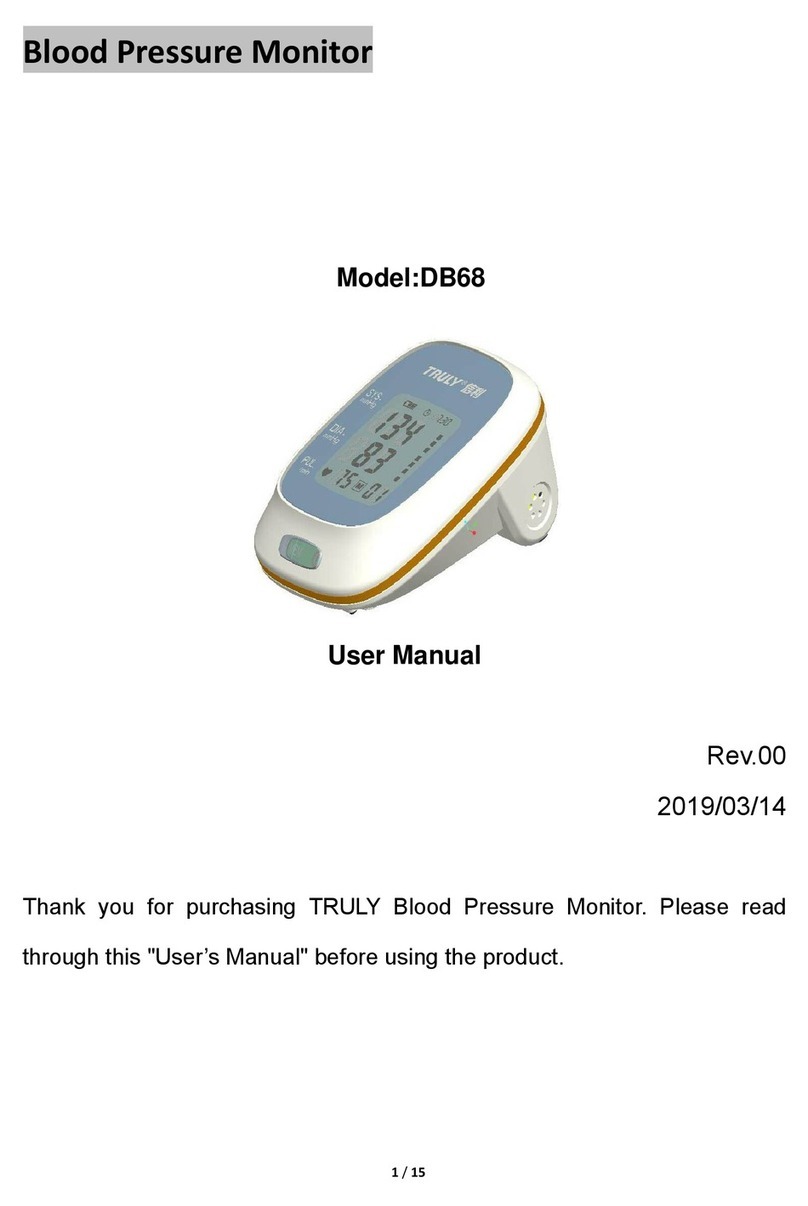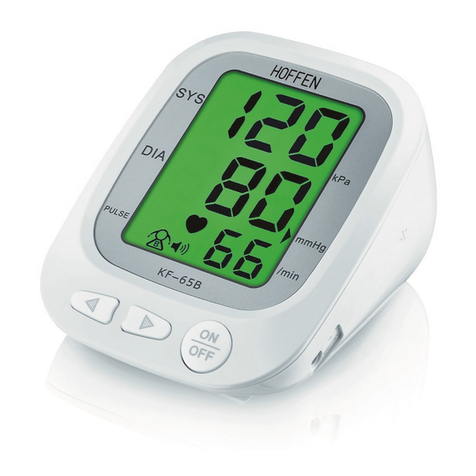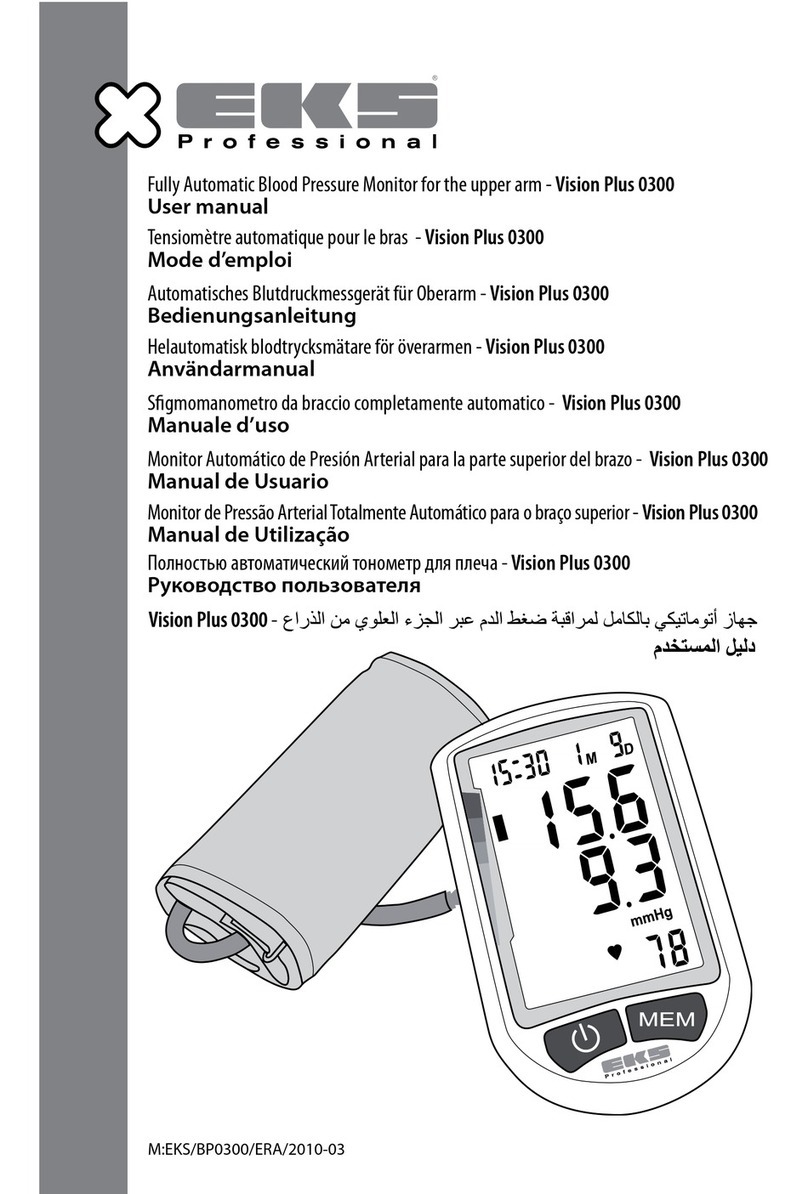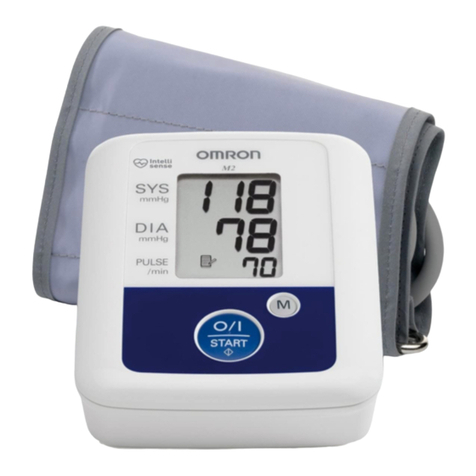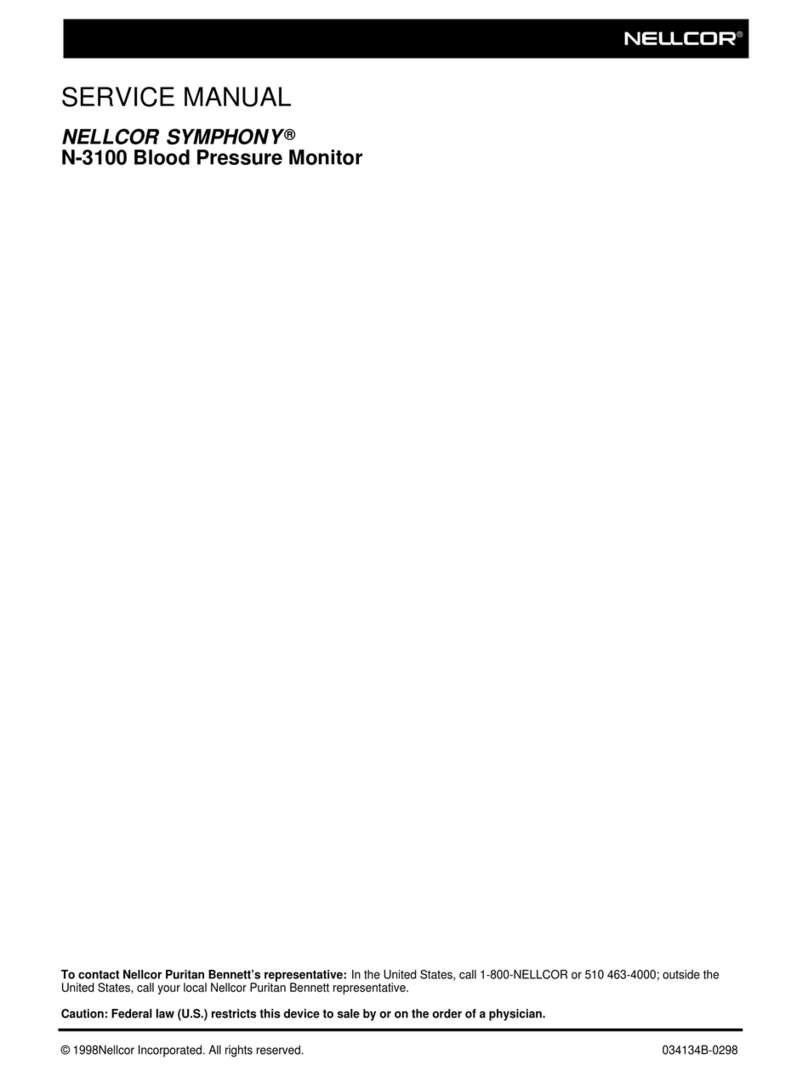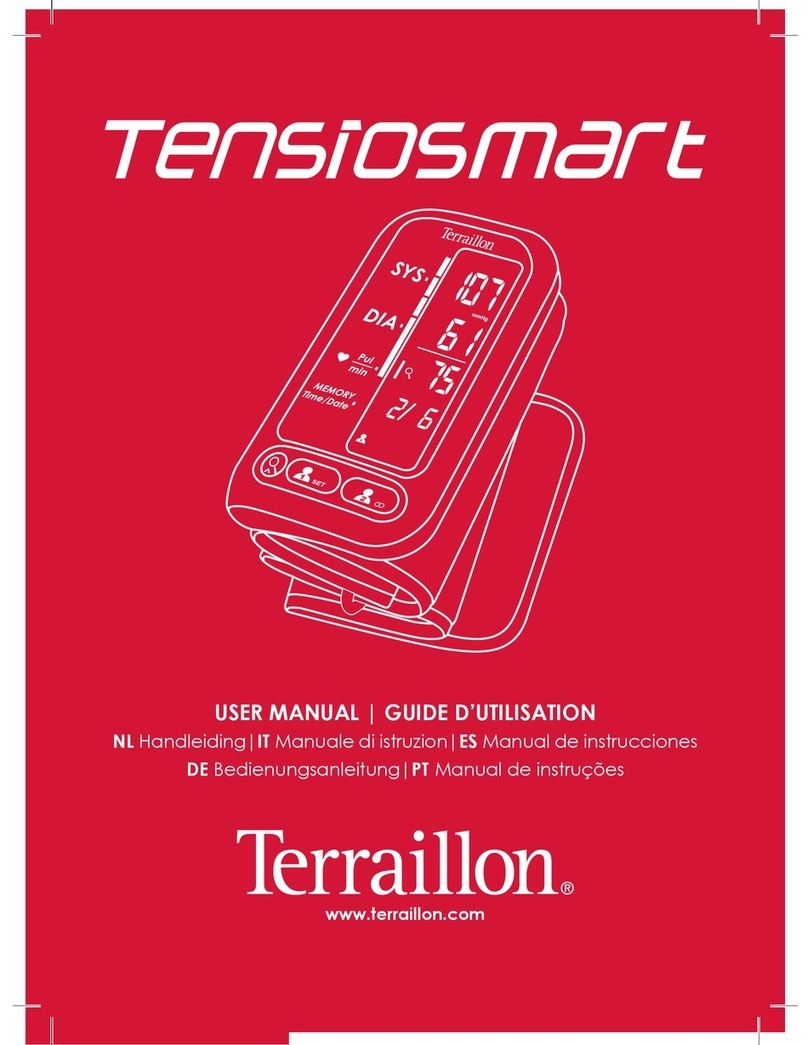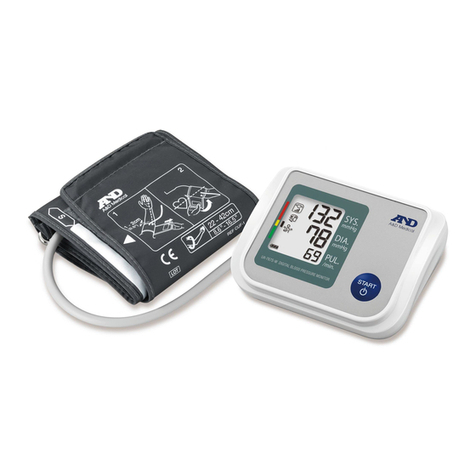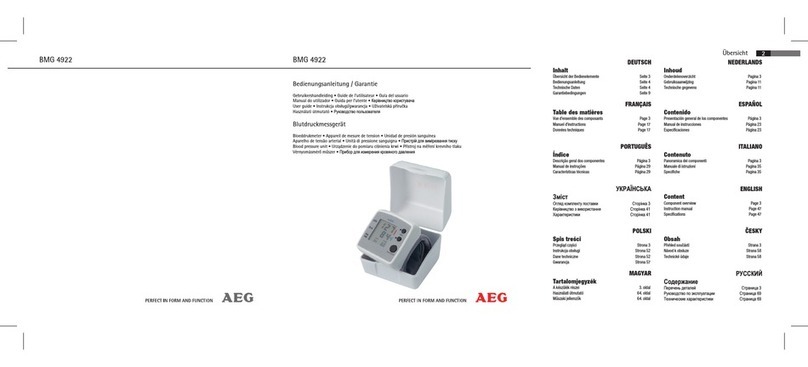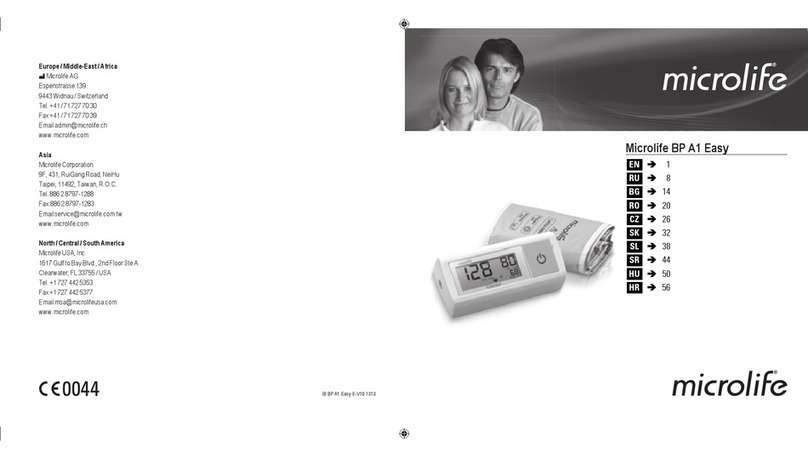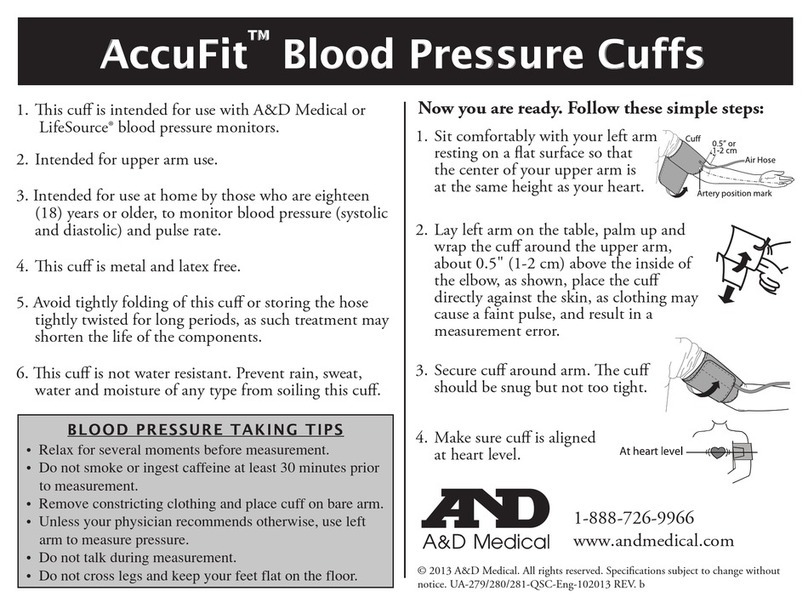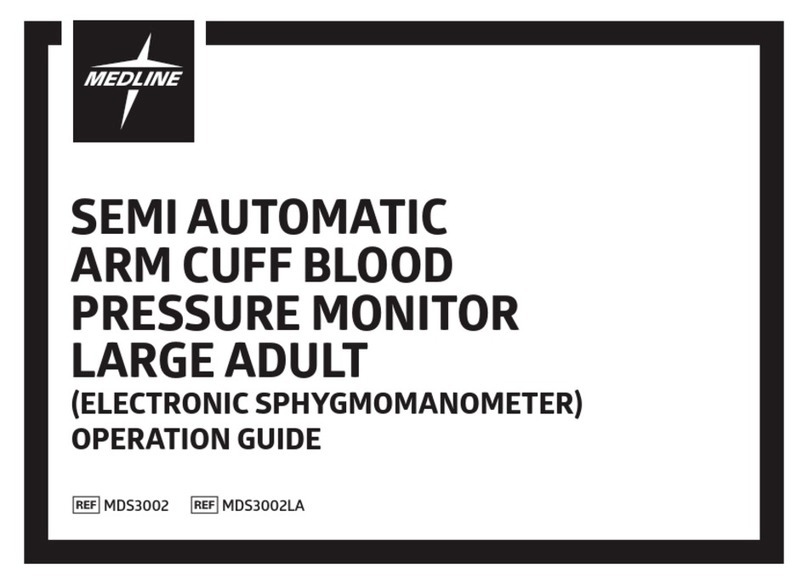Prolife Professional Aneroid Blood Pressure Kit User manual

ANEROID
BLOOD PRESSURE KIT
Prolife Professional
BG Инструкции за употреба
RU Руководство по эксплуатации
EN Instruction Manual

2
CONTENTS
1 Introduction ............................................................................................................................................. 3
1.1 Features of the Aneroid Blood Pressure Kit Prolife Professional.................... 3
1.2 Important information about self-measurement................................................... 3
2 List of symbols ........................................................................................................................................ 3
3 Important information on the subject of blood pressure
and its measurement.......................................................................................................................... 4
3.1 How does high/low blood pressure arise? ................................................................. 4
3.2 Which values are normal?...................................................................................................... 4
3.3 What should you do if high or low pressure is regularly detected?...............5
4 The components of the blood pressure monitor ............................................................ 6
5 Measurement...........................................................................................................................................7
5.1 Before the measurement........................................................................................................7
5.2 Common sources of error ....................................................................................................7
5.3 Fitting the cuff................................................................................................................................7
5.4 Measuring procedure............................................................................................................... 8
5.4.1 Connecting the stethoscope tube to the chest piece.................................... 8
5.4.2 Cuff inflation............................................................................................................................... 9
5.4.3 Systolic blood pressure measurement ..................................................................... 9
5.4.4 Diastolic blood pressure measurement .............................................................. 10
5.4.5 Record of measurements................................................................................................ 10
6 Troubleshooting ............................................................................................................................... 10
7 Care and maintenance....................................................................................................................11
8 Technical specifications ..................................................................................................................12
9 Safety ..........................................................................................................................................................12
10 Certification ............................................................................................................................................13
11 Warranty ...................................................................................................................................................13
ANEROID BLOOD PRESSURE KIT PROLIFE PROFESSIONAL EN

3
EN
1 INTRODUCTION
1.1. FEATURES OF THE PROLIFE PROFESSIONAL
Thank you for purchasing the Aneroid Blood Pressure Kit Prolife Professional.
The Aneroid Blood Pressure Kit Prolife Professional is a manual upper arm
blood pressure monitor. This device is intended for use in medical institutions
such as hospitals, clinics and medical offices, including self-use at home. This
device features excellent performance characteristics and favorable price. With
its state-of-the-art, non-stop needle valve mechanism and ergonomic bulb,
the
Aneroid Blood Pressure Kit Prolife Professional
provides you with accurate
and reliable measurements. A wear-proof cuff and durable materials ensure
the reliability of the blood pres
sure monitor. For ease of transportation, the de-
vice can be stored in a nylon zipper bag.
Please read this instruction manual carefully and keep it in a safe place.
For further questions on the subject of blood pressure and its measurement,
please contact your doctor.
WARNING
SAFETY INFORMATION
1.2. IMPORTANT INFORMATION ABOUT SELF-MEASUREMENT
Do not forget: self-measurement means control, not diagnosis or treatment.
Unusual values must always be discussed with your doctor. Under no circum-
stances should you alter the dosages of any drugs prescribed by your doctor.
2 LIST OF SYMBOLS
Symbols Meaning
Manufacturer.
Authorized Representative in the EU.
Read the instruction manual carefully before use.
Note / Warning.
The product complies with the Medical Devices Directive 93/42/EEC.

4
3 IMPORTANT INFORMATION ON THE SUBJECT
OF BLOOD PRESSURE AND ITS MEASUREMENT
3.1. HOW DOES HIGH/LOW BLOOD PRESSURE ARISE?
The level of blood pressure is determined in a part of the brain, the so-called circu-
latory center, and adapted to the respective situation by way of feedback via the
nervous system. To adjust the blood pressure, the strength and frequency of the
heart (Pulse), as well as the width of circulatory blood vessels is altered. The latter
is effected by way of fine muscles in the blood-vessel walls. The level of arterial
blood pressure changes periodically during the heart activity: during the «blood
ejection» (Systole) the value is maximal (systolic blood pressure value), at the end
of the heart’s «rest period» (Diastole) the value is minimal (diastolic blood pressure
value). The blood pressure values must lie within certain normal ranges in order
to prevent particular diseases.
3.2. WHICH VALUES ARE NORMAL?
Blood pressure is too high if at rest the diastolic pressure is above 90 mm Hg and/
or the systolic blood pressure is over 140 mm Hg. In this case, please consult your
doctor immediately. Long-term values at this level endanger your health due to
the associated advancing damage to the blood vessels in your body.
With blood pressure values that are too low, i.e. systolic values under 90 mm Hg
and/or diastolic values under 60 mm Hg, likewise, please consult your doctor.
Even with normal blood pressure values, a regular self-check with your blood
pressure monitor is recommended. In this way you can detect possible changes
in your values early and react appropriately.
If you are undergoing medical treatment to control your blood pressure, please
keep a record of your blood pressure level by carrying out regular self-measure-
ments at specific times of the day. Show these values to your doctor. Never
use the results of your measurements to alter independently the drug doses
prescribed by your doctor.
Table for classifying blood pressure values (unit: mm Hg) according to the
World Health Organization:
Range Systolic blood
pressure
Diastolic blood
pressure Recommendations
Hypotension <100 <60 Consult your doctor
Blood pressure opti-
mum 100–120 60–80 Self-check

5
EN
Blood pressure
normal 120–130 80–85 Self-check
Blood pressure
slightly high 130–140 85–90 Consult your doctor
Blood pressure too
high 140–160 90–100 Seek medical advice
Blood pressure far
too high 160–180 100–110 Seek medical advice
Blood pressure
dangerously high ≥180 ≥110 Urgently seek medi-
cal advice!
Further information
If your values are mostly standard under resting conditions, but exceptionally
high under conditions of physical or psychological stress, it is possible that you
are suffering from so-called «labile hypertension». Please consult your doctor if
you suspect that this might be the case.
3.3. WHAT SHOULD YOU DO IF HIGH OR LOW PRESSURE IS
REGULARLY DETECTED?
a. Consult your doctor.
b. The increased blood pressure (various forms of hypertension) observed over
a period of time is associated with substantial health risks. The increased
pressure has a negative effect on blood vessels which may be damaged
due to deposits in their walls (atherosclerosis). This may cause inadequate
blood supply to major organs (heart, brain, muscles). In addition, heart struc-
ture problems occur.
c. There are a variety of reasons for increased blood pressure. There are essen-
tial (the most frequent) hypertension and secondary hypertension. Secondary
hypertension is caused by disorder of certain organs. Consult your doctor for
possible reasons of high blood pressure.
d. Make some lifestyle changes to prevent and reduce high blood pressure.
These changes should be part of your lifestyle, and they include:
1. Eating habits.
•Try to maintain a normal weight appropriate for your age. Lose excess
weight!
•Avoid the excessive salt intake.
•Avoid fatty food intake.

6
2. Existing diseases.
Treat the existing diseases consistently following your doctor’s directions:
•Diabetes mellitus.
•Impaired fat metabolism.
•Gout.
3. Habits.
•Quit smoking completely.
•Limit alcohol consumption.
4. Physical state of the body.
•Do sports regularly after having passed a medical examination.
•Perform endurance exercises and avoid strength sports.
•Do not exhaust yourself with training.
•If you have any illnesses and / or if you are over 40, consult your
doctor before doing sports. He/she will help you to develop an
individual exercise program.
4 THE COMPONENTS OF THE BLOOD
PRESSURE MONITOR
Below it is drawn the manual blood pressure monitor, consisting of such
parts as:
Manometer
Cu
Chest piece
Case bag
Ear tips
Stethoscope
Bulb with valve

7
EN
5 MEASUREMENT
5.1. BEFORE THE MEASUREMENT
a. Avoid eating, smoking as well as all forms of exertion immediately before
the measurement. All these factors influence the measurement results. Find
some time to relax by sitting in an armchair in a quite atmosphere for about
ten minutes before the measurement.
b. Remove any clothes from your left arm. Do not roll up the sleeve as it will
squeeze your arm and this will lead to inaccurate measurement results.
c. Measure always on the same arm (normally left).
d. Attempt to carry out the measurements regularly at the same time of day,
since the blood pressure changes during the course of the day.
5.2. COMMON SOURCES OF ERROR
NOTE
Comparable blood pressure measurements always require the same condi-
tions! These are normally always quiet conditions.
•All efforts by the patient to support the arm can increase the blood
pressure. Make sure you are in a comfortable, relaxed position and do
not activate any of the muscles in the measurement arm during the
measurement.
•Make sure that the point of the air tube entry in the cuff is located above
the cubital fossa and is at the level of the heart. If this point is 15 cm above
the level of the heart, the measured systolic pressure will be about 10 mm
Hg lower than the true value and vice versa.
•Use only the original cuff.
•A loose or improperly fitted cuff causes false measurement values.
5.3. FITTING THE CUFF
a. Wrap the cuff around your arm
so that the tube is directed from
the bottom upwards.

8
b.
Apply the cuff to the arm as shown in
the figure.
Make sure that the bottom edge of
the cuff is approximately 2–3 cm
above the elbow and that the tube
is on the inside of your arm.
c. Tighten the loose end of the cuff and
1–2 см
secure it with the Velcro fastener.
d. The cuff should be fixed on the upper arm not too tightly. Remove any
clothes from your arm (for example, sweater).
e. Lay the arm on a table, with the palm
upwards, so that the cuff is located
at the heart level. Avoid twisting
the tube.
NOTE
The cuff can be put on the right arm as well. In this case, all measurements must
be made on the same arm.
5.4. MEASURING PROCEDURE
5.4.1. Do not place the chest piece on/in the cuff. The chest piece should be
placed either under the cuff or 1–2 cm below the cuff. The chest piece is placed
properly when the Korotkoff sounds are loud. Make sure the chest piece is in
contact with skin and placed over the brachial artery. Insert the ear tips correctly
to check the Korotkoff sounds during the measurement. Before using the stetho-
scope, make sure that there are no cracks in the membrane, ear tips or the tube.
Wrong position or damage of the stethoscope will result in sound distortion or
poor sound transmission, leading to inaccurate measurements.
2–3 сm
tube

9
EN
5.4.2. CUFF INFLATION
Close the air valve of the rubber bulb by turn-
ing the screw clockwise. Do not overtighten.
Squeeze the rubber bulb in your hand evenly
until the manometer pointer exceeds your nor-
mal systolic pressure by 30 mm Hg. If you are
not sure of this value, first inflate the cuff to a
pressure level of 200 mm Hg.
5.4.3. SYSTOLIC BLOOD PRESSURE MEASUREMENT
Slowly open the air valve by turning the screw
counterclockwise and hold the working part of
the stethoscope over the brachial artery. To ob-
tain accurate readings, the correct rate of air re-
lease from the cuff is required. The air should be
released at a rate of 2–3 mm Hg/s, or reducing
the pressure by one or two scale divisions with
every heartbeat.
Do not remain the cuff inflated longer than re-
quired. When the cuff starts to deflate, you must
listen carefully to the sounds through a stetho-
scope. Bear in mind the manometer readings as you hear a clear, rhythmic knock
or beat. This is the systolic blood pressure value. Listen carefully to the heartbeat
sounds (Korotkoff).
Analog pressure
gauge
cuff
artery
phonendoscope

10
5.4.4. DIASTOLIC BLOOD PRESSURE MEASUREMENT
Allow pressure to drop at the same air release rate. When the diastolic blood pres-
sure value is reached, the beat sound is no longer audible. Completely deflate the
cuff. Remove the cuff and ear tips.
5.4.5. RECORD OF MEASUREMENTS
Repeat the measurement at least twice. Remember to record your measurement
results, as well as the time and date of the measurement immediately after the
measurement. The most suitable time for measurement is morning, immediately
after sleep, or just before dinner.
NOTE
Do not perform measurements without a pause in order to avoid distortion of
results.
Sit or lie for 1 minute before repeating the measurement.
The following types of cuffs Prolife are available:
•cuff Prolife 07–12 cm for children, small size, XS, without ring
•cuff Prolife 25–40 cm for adults, medium size, L, without ring
•cuff Prolife 40–66 cm for adults, large size, ХL, without ring
•cuff Prolife 25–36 cm for adults, medium size, M, with ring
•cuff Prolife 33–46 cm for adults, large size, L, with ring
6 TROUBLESHOOTING
If problems occur when using the device, the following points should be checked
and if necessary, the corresponding measures are to be taken:
Malfunction Remedy
Poor sound
transmission,
distortion or
continuous noise
1. Check if the ear tips are clogged. If not, make sure they are snug
and not worn.
2. Check if the tube is cracked or twisted.
3. Check for cracks in the stethoscope membrane.
4. Make sure the working part of the stethoscope properly contact
with the skin
The pressure
does not increase
when inflating
the cuff with a
bulb
1. Make sure the valve is closed.
2. Make sure the cuff is properly connected to the rubber bulb and ma-
nometer.
3. Check the cuff, tube and bulb for leakage.
Please contact the service center for replacing the parts

11
EN
The air release
rate cannot be set
to 2–3 mm Hg/s
Disconnect the valve from the bulb to check if there are any obsta-
cles to the air inside the valve. If the valve does not work properly, it
must be replaced. Please contact the service center
At rest, the pointer
is not at
the mark
0+/– 3 mm Hg
1. Make sure the valve is fully open during zero adjustment.
2. P
lease contact the service center in case the deviation exceeds 3 mm Hg
Further information
The level of blood pressure is subject to fluctuations even with healthy people. It
is Important thereby that comparable measurements are carried out in the same
conditions (quiet conditions)!
However, if there are technical problems in the blood pressure monitor, please
contact the service center. Never attempt to repair the instrument yourself! Any
unauthorized opening of the instrument invalidates all guarantee claims!
7 CARE AND MAINTENANCE
Proper care and maintenance ensure a long-life performance of the instrument.
WARNING
Clean the instrument only with a soft, dry cloth.
Follow the general rules below:
•Do not drop the instrument.
•Never inflate the cuff to a pressure value exceeding your normal systolic
pressure by 30 mm Hg.
•Do not expose the device to extreme temperatures, humidity or direct
sunlight.
•Avoid contact of the cuff fabric with sharp tools which may damage
the cuff.
•Keep the cuff completely deflated.
•Do not disassemble the manometer under any circumstances.
•Store the complete set in a case bag so that all parts remain clean.
•Storage conditions: –10°С +70°С at relative humidity of 85% (non-condensing).
•Clean the manometer and the rubber bulb with a soft cloth. Disinfection
is not necessary, because the manometer parts should not directly contact
with the patient’s body parts during the measurement.

12
Periodic instrument calibration
The accuracy of sensitive measuring instruments should be periodically checked.
We recommend to check the static pressure indication every couple of years.
Please contact the service center for more detailed information.
8 TECHNICAL SPECIFICATIONS
Type Aneroid Blood Pressure Kit
Model Prolife Professional
Weight, g 400
Dimensions (LxWxH), mm 175x95x60
Storage conditions Temperature range: from –10°С to +50°С
Relative humidity: up to 85%
Operating conditions Temperature range: from +10°С to +40°С
Relative humidity: up to 85%
Measuring range From 0 to 300 mm Hg
Instrument uncertainty +– 3 mm Hg within 18°С – 33°С
+– 6 mm Hg within 34°С – 40°С
Delay error 0–4 mm Hg
9 SAFETY
Safety and care
•This instrument may be used only for the purpose described in this
manual. The manufacturer is not liable for damages caused by improper
use of the instrument.
•This instrument consists of sensitive components which should be treated
with caution. Observe the storage and operating conditions described in
the «Care and maintenance» section!
•Protect the instrument from water and moisture, extreme tempera-
tures, impact and dropping, contamination and dust, direct sunlight,
heat and cold.

13
EN
•Do not use the instrument if you think it is damaged or notice anything unusual.
Read the additional safety instructions in the individual sections of
this manual. Ensure that children do not use the instrument unsuper-
vised: some parts are small enough to be swallowed. Do not allow
playing with the instrument! Keep the instrument away from children.
•Use only approved accessories, detachable parts and materials, if the use of
other parts or materials is unsafe.
10 CERTIFICATION
STANDARD COMPLIANCE
The
Aneroid Blood Pressure Kit
Prolife Professional blood pressure monitor
complies with Directive 93/42/EEC.
11 WARRANTY
The Aneroid Blood Pressure Kit
Prolife Professional
is guaranteed for 2 years
from the date of purchase in case of self-used at home and for 1 year in case of
used in medical institutions. The guarantee is only valid upon presentation of the
guarantee card filled out by the authorized representative and the receipt.
Warranty period of the device
components is the following
Service life of the device
components is the following
when used in
medical institutions
when self -
used at
home
when used in
medical institutions
when self -
used at
home
Manometer 1 year 2 years 10 years 10 years
Cuff 1 year 2 years 10 years 10 years
Stethoscope 1 year 2 years 10 years 10 years
WARNING
After-sales and free maintenance services are not provided in case of:
•using the device with violation of requirements specified in the instruction
manual;
•damage caused by deliberate or erroneous actions of the consumer due
to mishandling or negligence, as well as in other cases of violation by the
consumer of storage, cleaning, transportation and operation requirements
specified in the instruction manual.

14
WARNING
•Follow the instructions precisely to ensure reliable and long-term opera-
tion of the device.
•In case of abnormal operation of the device, please contact the seller.
•For repair and maintenance, please contact a specialized after-sales service.
•The manufacturer reserves the right to make structural changes of the device.
WARNING
The guarantee is only valid upon presentation of the guarantee card filled
out by the seller.
The information of the date of mass production and the manufacture is
placed on the individual package.

15
EN

16
СОДЕРЖАНИЕ
1 Введение .................................................................................................................................................17
1.1 Особенности..............................................................................................................................17
1.2 Важные указания по самостоятельному измерению
артериального давления ..................................................................................................17
2 Список обозначений......................................................................................................................18
3 Важная информация об артериальном давлении и его измерении...........18
3.1 Kак возникает повышенное или пониженное давление?.........................18
3.2 Kакое давление является нормальным? ................................................................18
3.3 Что делать если регулярно определяется повышенное или
пониженное давление........................................................................................................18
4
Составные части измерителя для измерения артериального давления
...21
5 Процедура измерения..................................................................................................................22
5.1 Перед измерением................................................................................................................22
5.2 Часто встречающиеся ошибки .....................................................................................22
5.3 Hаложение манжеты.............................................................................................................22
5.4 Процедура измерения........................................................................................................23
5.4.1
Подсоединение трубки фонендоскопа к головке фонендоскопа
......23
5.4.2 Накачивание манжеты ....................................................................................................24
5.4.3 Измерение систолического артериального давления .........................24
5.4.4 Измерение диастолического артериального давления ......................25
5.4.5 3апись произведенных измерений ......................................................................25
6 Неисправности и средства их устранения ...................................................................26
7 Уход за измерителем......................................................................................................................27
8 Технические данные.......................................................................................................................27
9 Техника безопасности...................................................................................................................28
10 Сертификация......................................................................................................................................28
11 Гарантия .................................................................................................................................................29
ИЗМЕРИТЕЛЬ АРТЕРИАЛЬНОГО ДАВЛЕНИЯ PROLIFE PROFESSIONAL RU

17
RU
1 ВВЕДЕНИЕ
1.1. ОСОБЕННОСТИ
Благодарим Вас за покупку измерителя артериального давления Prolife
Professional.
Измеритель артериального давления Prolife Professional является неавтома-
тическим, механическим измерителем для измерения давления, использую-
щимся на плечевой зоне. Данный прибор предназначен для использования
в медицинских учреждениях, таких как больницы, клиники и медицинские
кабинеты, в том числе и в домашних условиях. Измеритель отличается превос-
ходными эксплуатационными характеристиками и экономичной ценой. При
помощи современного механизма с игольчатым клапаном и эргономич-
ным нагнетателем, измеритель артериального давления Prolife Professional
обеспечивает Вам точные и достоверные измерения. Износостойкая манжета
и прочные материалы, используемые в механическом измерителе давления,
обеспечивают надежность измерителя. Для удобства транспортировки изме-
ритель может храниться в нейлоновой сумке с застежкой.
Пожалуйста, внимательно прочтите это руководство и сохраните его.
Eсли у вас имеются дополнительные вопросы в отношении артериального
давления и его измерения, проконсультируйтесь у вашего врача.
ВНИМАНИЕ
ИНФОРМАЦИЯ ПО БЕЗОПАСНОСТИ
1.2. ВАЖНЫЕ УКАЗАНИЯ ПО САМОСТОЯТЕЛЬНОМУ ИЗМЕРЕНИЮ
АРТЕРИАЛЬНОГО ДАВЛЕНИЯ
Помните о следующем: самостоятельные измерения выполняются для
контроля, а не для постановки диагноза или лечения. О необычных
результатах обязательно следует сообщить врачу. Hи в коем случае не
изменяйте самостоятельно прописанные вашим врачом лекарства или
их дозировку.

18
2 СПИСОК ОБОЗНАЧЕНИЙ
Cимвол Значение
Производитель.
Уполномоченный представитель производителя в ЕС.
Перед использованием внимательно ознакомьтесь с инструкцией.
Предупреждение / Внимание.
Изделие соответствует Директиве ЕС 93/42/EEC о медицинских
изделиях.
3 ВАЖНАЯ ИНФОРМАЦИЯ
ОБ АРТЕРИАЛЬНОМ ДАВЛЕНИИ
И ЕГО ИЗМЕРЕНИИ
3.1.
KАК ВОЗНИКАЕТ ПОВЫШЕННОЕ ИЛИ ПОНИЖЕННОЕ ДАВЛЕНИЕ?
Уровень артериального давления определяется в особом участке мозга, так
называемом центре кровообращения, и регулируется им в зависимости от
ситуации путем посылки ответных сигналов по нервным путям. Для регули-
ровки артериального давления изменяется сила и частота сердцебиения
(пульс), а также ширина кровеносных сосудов (ширина сосудов изменяет-
ся маленькими мышцами в стенках сосудов). Уровень артериального давле-
ния периодически изменяется в процессе сердечной деятельности: во время
«выброса крови» (систолы) значение давления максимально (систолическое
значение давления), в конце фазы покоя (диастолы) - минимально (диасто-
лическое значение давления). Значения артериального давления должны
находиться в определенном нормальном диапазоне, что необходимо для
предотвращения некоторых заболеваний.
3.2. КАКОЕ ДАВЛЕНИЕ ЯВЛЯЕТСЯ НОРМАЛЬНЫМ?
Артериальное давление считается повышенным, если в состоянии покоя
диастолическое давление составляет более 90 мм ртутного столба и/или
систолическое давление составляет более 140 мм ртутного столба. B этом

19
RU
случае рекомендуется незамедлительно обратиться к врачу. Длительное
сохранение давления на таком уровне представляет опасность для вашего
здоровья, так как оно вызывает прогрессирующее повреждение кровенос-
ных сосудов в вашем организме.
K врачу также следует обратиться и при слишком низком артериальном
давлении, а именно при систолическом давлении менее 90 мм рт. ст. и/или
диастолическом давлении менее 60 мм рт. ст. Даже если измеренные значе-
ния давления находятся в норме, рекомендуем с помощью вашего изме-
рителя регулярно контролировать свое артериальное давление, чтобы
своевременно распознать возможные отклонения давления и предпринять
необходимые действия.
Eсли вы проходите курс лечения по регулированию артериального давления,
регулярно выполняйте измерения артериального давления в определенные
часы и записывайте их в журнал. Впоследствии покажите эти записи вашему
врачу. Hи в коем случае не изменяйте самостоятельно на основе результа-
тов измерения давления прописанные вашим врачом медикаменты или их
дозировку.
Таблица значений артериального давления крови (в единицах mm Hg)
согласно классификации Всемирной Организации Здравоохранения:
Диапазон Систолическое Диастолическое Рекомендации
Артериальное
давление слишком
низкое
<100 <60 Обратитесь к
врачу
Оптимальное арте-
риальное давление 100–120 60–80 Самостоятель-
ный контроль
Артериальное
давление в норме 120–130 80–85 Самостоятель-
ный контроль
Артериальное
давление слегка
повышено
130–140 85–90 Обратитесь к
врачу
Артериальное
давление слишком
высокое
140–160 90–100
Обратитесь за
медицинской
помощью
Артериальное
давление чрезмер-
но высокое
160–180 100–110
Обратитесь за
медицинской
помощью

20
Артериальное
давление угрожаю-
ще высокое
≥180 ≥110
Незамедлитель-
но обратитесь
за медицинской
помощью
Прочие указания
Если значения давления, измеренные в состоянии покоя, не являются
необычными, а в состоянии физического или душевного переутомления вы
наблюдаете чрезмерно повышенные значения, это может указывать на нали-
чие так называемой артериальной лабильной гипертензии. В любом случае,
обсудите результаты с Вашим врачом.
3.3. ЧТО ДЕЛАТЬ, ЕСЛИ РЕГУЛЯРНО ОПРЕДЕЛЯЕТСЯ ПОВЫШЕННОЕ
ИЛИ ПОНИЖЕННОЕ ДАВЛЕНИЕ?
a. Обратитесь к врачу.
b. Повышенное значение артериального давления (различные формы
гипертонии), наблюдаемые в течение некоторого периода, связа-
ны с существенными опасностями для здоровья. Повышенное давле-
ние оказывает негативное влияние на кровеносные сосуды, которые
подвергаются опасности повреждения в результате отложений в стен-
ках сосудов (атеросклероз). Это может привести к недостаточному
кровоснабжению важных органов (сердца, мозга, мышц). Кроме того,
возникают нарушения в структуре сердца.
c. Повышенное артериальное давление может быть вызвано множеством
причин. Различают часто встречаемую первичную (эссенциальную) ги-
пертензию и вторичную гипертензию. Вторичная гипертония вызывается
нарушением в работе определенных органов. В отношении возможных
причин повышенного давления проконсультируйтесь у Вашего врача.
d. Чтобы предупредить и снизить повышенное артериальное давление,
можно произвести некоторые изменения образа жизни. Эти изменения
должны стать частью Вашего образа жизни, и к ним относятся:
1. Привычки в отношении питания.
•Стремитесь поддерживать нормальный вес, соответствующий ва-
шему возрасту. Снижайте избыточный вес!
•Избегайте чрезмерного потребления поваренной соли.
•Избегайте употребления жирной пищи.
Table of contents
Languages:
Other Prolife Blood Pressure Monitor manuals


